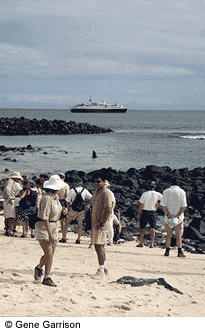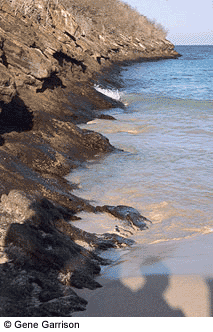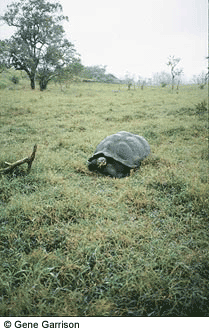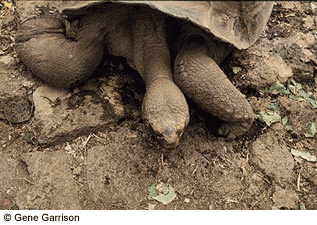 Begin in Ecuador, South America, on the continental western coast with Columbia on the north and Peru on the east and south.Next, take a left turn and continue west from the city of Guayaquil across the Pacific Ocean for 600 miles, and you’ll find the Galapagos, an archipelago consisting of thirteen islands.Naturalist Charles Darwin made the riches of the flora and fauna of these land masses famous in 1835.Today, we associate his name with one of his most important scientific writings, Origins of the Species, which was inspired by the observations he made in the islands.
Begin in Ecuador, South America, on the continental western coast with Columbia on the north and Peru on the east and south.Next, take a left turn and continue west from the city of Guayaquil across the Pacific Ocean for 600 miles, and you’ll find the Galapagos, an archipelago consisting of thirteen islands.Naturalist Charles Darwin made the riches of the flora and fauna of these land masses famous in 1835.Today, we associate his name with one of his most important scientific writings, Origins of the Species, which was inspired by the observations he made in the islands.
After a flight from Miami to Guayaquil, an Ecuadorian airplane delivered the World Wildlife Fund TravelGroup–including my husband Bert and me–to the tiny island of Baltra.The airstrip we used was built by the United States during World War II for the protection of its interests in the area–mainly the Panama Canal.Although the members of our expedition group were dressed in identical t-shirts, we knew we had more than appearance in common.We were all determined to be as gentle as possible to both the land and its inhabitants.We had heard that the animals on Galapagos are unafraid of humans.They don’t know that humans are predators.
Our adventure began with a bouncy, five-minute bus ride to a small wooden dock where we were to board our ship.A sea lion watched us arrive with apathetic curiosity, unperturbed by the group of two-legged animals with cameras hanging about their necks.A rubber raft with an outboard motor pulled up to the dock. (The natives call the crafts pongas, but the manufacturer calls them Zodiacs.)Off in the distance, I saw the Polaris, the largest ship in sight, even though it carries only about eighty passengers.
 After closing the gap between dock and ship, we climbed the steps, received the expected welcome, and were escorted to our cabins.Our bilingual guide showed us our small quarters, adding in his soothing baritone voice, “I’m here to serve you.”He was also the maitre’d.Our meals turned out to be top-notch, beginning with a special Ecuadorian luncheon–a feast!The kitchen crew had knocked themselves out to present an array of foods that few of us had ever experienced.
After closing the gap between dock and ship, we climbed the steps, received the expected welcome, and were escorted to our cabins.Our bilingual guide showed us our small quarters, adding in his soothing baritone voice, “I’m here to serve you.”He was also the maitre’d.Our meals turned out to be top-notch, beginning with a special Ecuadorian luncheon–a feast!The kitchen crew had knocked themselves out to present an array of foods that few of us had ever experienced.
To help us pursue our interests in wildlife, Zodiacs transported us to special places at least twice a day.We were told that we would have both wet and dry landings.They were mostly wet.That meant that we would get out of the raft in water, usually ankle-deep.Shorts were the uniform-of-the-day for splashes, and amphibious-type sandals with rubber soles were practical for both water and land.
The naturalists emphasized that we were to stay on the trails.One warned, “A sea lion may walk up to you and look like it wants to be petted.DON’T!”She was serious.
The first island we visited was Española.We found ourselves walking gingerly on the beach.Sea lions stretched out languidly.One female was nursing a pup.As I walked by, perhaps three feet from her, she raised her head to see who or what I was, then flopped down, closed her eyes, and went to sleep—with the young one still nursing.Sea lions crowded the beach as well as the ocean.Beaded-looking giant iguanas staked their territorial claim on the rocks and white sand.We were delighted with the names of the creatures.Who wouldn’t smile when looking at a Sally Lightfoot Crab?Mostly bright orange with touches of yellow and blue, the crabs park themselves among the iguanas on the rocks, build underground homes in the sand, and venture out into the ocean.
Each member of our group carried at least one camera.I’d advise anyone considering such a trip to take more film than you think you’ll need, a telephoto lens, filters–if you usually use them, batteries, and an extra camera.I heard one woman lamenting, “I‘m the only one on this whole ship who brought a point-and-shoot camera.I’m really embarrassed.”She shouldn’t have been embarrassed.My point-and-shoot camera was a life-saver after my SLR was damaged.
The blue-footed booby is a species that’s found only in the Galapagos.The stories about how proud they are of their blue feet are amusing.In the mating dance, males stand on one leg and extend the other leg to show off for their prospective mates.If they manage to impress the females, the females join in the dance.These black-and-white and sometimes brown birds are about duck-size.A friend told me about a booby that was attracted to her traveling companion’s blue slacks.(There are also red-footed and masked boobies, but the blue-footed boobies are the stars.)
 Still on the Island of Española, we opted to go on a one-and-a-half-mile hike through scrubby soil.Not pretty, the trail is piled with loose, sharp-edged rocks (actually small boulders).This hike took three hours and turned out to be one that we would rather have skipped—perhaps to go snorkeling.
Still on the Island of Española, we opted to go on a one-and-a-half-mile hike through scrubby soil.Not pretty, the trail is piled with loose, sharp-edged rocks (actually small boulders).This hike took three hours and turned out to be one that we would rather have skipped—perhaps to go snorkeling.
Snorkeling beside sea creatures was an activity we could choose almost every day.Those of our group who weren’t quite so adventurous could see the underwater world from a glass-bottomed boat, a ride that reveals all sorts of colorful formations as well as schools of brightly colored fish—yellow-tailed surgeonfish, blue-eyed damselfish, the Moorish idol, yellow-banded triggerfish, and white-banded angelfish.They flash vivid blues, oranges, yellows and greens in stripes and other delightful patterns as they course through the ocean.
We waded through shallow water day after day, onto island after island — Floreana with its extinct volcanoes; Fernandina’s tiny penguins, marine iguanas, and rope-like lava formations; and a black-sand beach at Santiago, complete with low-key snoozing sea lions, boobies everywhere, and fierce-looking iguanas clustered on warm, often wet, black rocks.Humans inhabit Santa Cruz.The Charles Darwin Research Station and the Galapagos tortoise-breeding program are located there.The harbor is full of fishing and pleasure boats.Native artisans set up tables of their wares, mostly wildlife carvings, in the town park, hoping to collect some tourist money.(In recent years, Ecuador changed their monetary system to dollars, so there’s no problem with rates of exchange.)A bus transported us to a local farm to see the Galapagos tortoises migrate across the fields.
On the ponga trip back to the ship, we were attracted to a great number of frigate birds (large swallow-tailed black birds) circling a fishing boat.Our pilot, hearing our oohs and ahhhs, headed closer. A fisherman was chopping off scrappy parts of large fish and tossing them into the water.Huge birds performed a ballet in the sky, and then dived for their treats.
After we returned home, we read that there had been violence at the Charles Darwin Research Station between the fishermen and the environmentalists.The environmentalists wanted to reduce the number of fish that the fishermen could legally catch, in order to protect various species, but the fishermen protested.The controversy reminded us that it’s a good idea to be aware of political activity and social unrest before traveling to any foreign country.

We had an adventure of a different kind at Genovesa Island.The people who wanted to climb up Prince Phillip’s Steps were to board the Zodiacs first.The huge, rocky, monolith rising out of the ocean had a crude two-by-four wooden construction up from the place where the Zodiacs let passengers off.Treacherous whitewater waves smashed against the cliffs.The rafts surged up and down and in and out with the tide.Everyone else gingerly made their way to the pilot, who helped them out onto the rocks.
Having accidentally boarded the wrong craft, my husband and I had to change vessels mid-ocean so that we could join the group already en route to a wildlife cruise.
We saw tropic birds, frigate birds, boobies, fur seals, sea turtles, shark fins, and—perhaps–whales. Two white tropic birds, the ones with long gracefully trailing tail feathers, created a drama that we were privileged to witness. I thought they were fighting to the death for nesting territory, but just when one appeared to be a winner, he turned and flew away, leaving the exhausted contender to limp off to his home in a cliff. Oystercatchers with long orange bills and orange eyes searched for dinner on the beach, and flamingos appeared in a distant lagoon. Darwin’s finches flitted about. We spotted brown pelicans in trees and watched as sea turtles mated in the ocean.
On departure day, we had our orders to check out by seven-thirty in the morning.Our luggage was to be placed outside our doors.There would be a slide show in the ship’s lounge entitled “Galapagos Retrospective,” so that we could sort out our memories.
By Gene K. Garrison

Leave a Reply